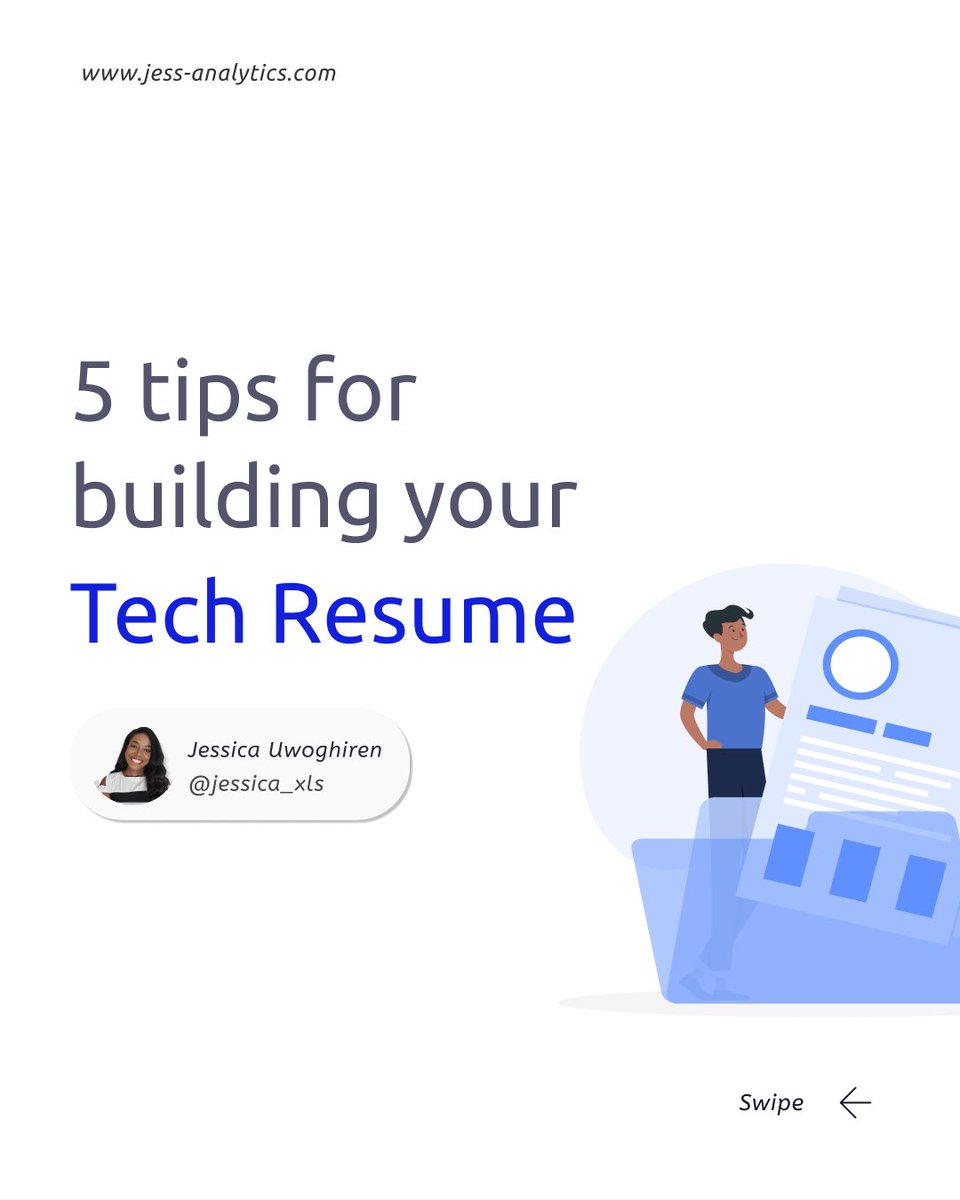
TIPS FOR BUILDING YOUR TECH RESUME
In one month I’ve gotten over 20 interview requests from various companies thanks to my awesome resume & God 😊. If you are a recent graduate or transitioning to Tech, this THREAD would be useful
#100DaysOfCode #TechTwitter #DataFam #jobsearch
In one month I’ve gotten over 20 interview requests from various companies thanks to my awesome resume & God 😊. If you are a recent graduate or transitioning to Tech, this THREAD would be useful
#100DaysOfCode #TechTwitter #DataFam #jobsearch

1/ BEFORE WE BEGIN
Some Tech roles that have low barrier to entry include Data Analyst, Data Scientist, Front End Developer, Product Manager or UI/UX Designer etc. You can be self-taught in any of this & land your dream job. Don't forget to RT or LIKE so others can learn too.
Some Tech roles that have low barrier to entry include Data Analyst, Data Scientist, Front End Developer, Product Manager or UI/UX Designer etc. You can be self-taught in any of this & land your dream job. Don't forget to RT or LIKE so others can learn too.
2/ RESUME SECTIONS
Your resume should have these sections
• Basic Information: Name, Email, Phone Number, LinkedIn URL, Portfolio Website & Location
• Skills: Technical skills (70%) & Soft skills (30%)
• Projects
• Work Experience
• Education/Certifications
• Volunteering
Your resume should have these sections
• Basic Information: Name, Email, Phone Number, LinkedIn URL, Portfolio Website & Location
• Skills: Technical skills (70%) & Soft skills (30%)
• Projects
• Work Experience
• Education/Certifications
• Volunteering

3/ RESUME FORMAT
• Your resume should be only one-page
• Make it catchy. First impressions matter
• Keep in mind that the HR team has several resumes to review
• Avoid bright colours. Go with semi-dark shades 🔵🔴🟣
• Your resume should be only one-page
• Make it catchy. First impressions matter
• Keep in mind that the HR team has several resumes to review
• Avoid bright colours. Go with semi-dark shades 🔵🔴🟣

4/ WORK EXPERIENCE
• If you’ve worked in >3 companies, only indicate the 3 most recent ones
• On changing job titles, I don't advise it. Tailor your achievements in previous roles towards your desired job
• Need an example on tailoring achievements? Check my LinkedIn profile
• If you’ve worked in >3 companies, only indicate the 3 most recent ones
• On changing job titles, I don't advise it. Tailor your achievements in previous roles towards your desired job
• Need an example on tailoring achievements? Check my LinkedIn profile

5/ APPLYING TO MULTIPLE JOBS
• To avoid tweaking your resumes for different jobs, have your resume tailored towards the common requirements for your desired role
• Eg. Data analyst roles require Tableau/PowerBI, SQL, Excel. For Data Science - Python/R, SQL, Tensorflow, Hadoop
• To avoid tweaking your resumes for different jobs, have your resume tailored towards the common requirements for your desired role
• Eg. Data analyst roles require Tableau/PowerBI, SQL, Excel. For Data Science - Python/R, SQL, Tensorflow, Hadoop

6/ CAREER TRANSITION & PROJECTS
• Switching Careers? Ensure you have 2 featured projects & relevant certifications on your resume related to your Tech field
• For recent graduates, your school projects & certifications will count. Internships count as work experience.
• Switching Careers? Ensure you have 2 featured projects & relevant certifications on your resume related to your Tech field
• For recent graduates, your school projects & certifications will count. Internships count as work experience.

7/ READY TO APPLY?
• LinkedIn has several job opportunities across the world. I use it for my job applications
• Ensure your @LinkedIn profile is top-notch.
• Be ready for when opportunities come
• Check the link in my bio for ONE-PAGE resume templates
• LinkedIn has several job opportunities across the world. I use it for my job applications
• Ensure your @LinkedIn profile is top-notch.
• Be ready for when opportunities come
• Check the link in my bio for ONE-PAGE resume templates

8/
Lastly, these tips have worked brilliantly for me & you should try them. Projects/Portfolio go a long way They show your competencies and increase your chances of getting the job. Pictures designed with @figmadesign
Lastly, these tips have worked brilliantly for me & you should try them. Projects/Portfolio go a long way They show your competencies and increase your chances of getting the job. Pictures designed with @figmadesign

• • •
Missing some Tweet in this thread? You can try to
force a refresh





